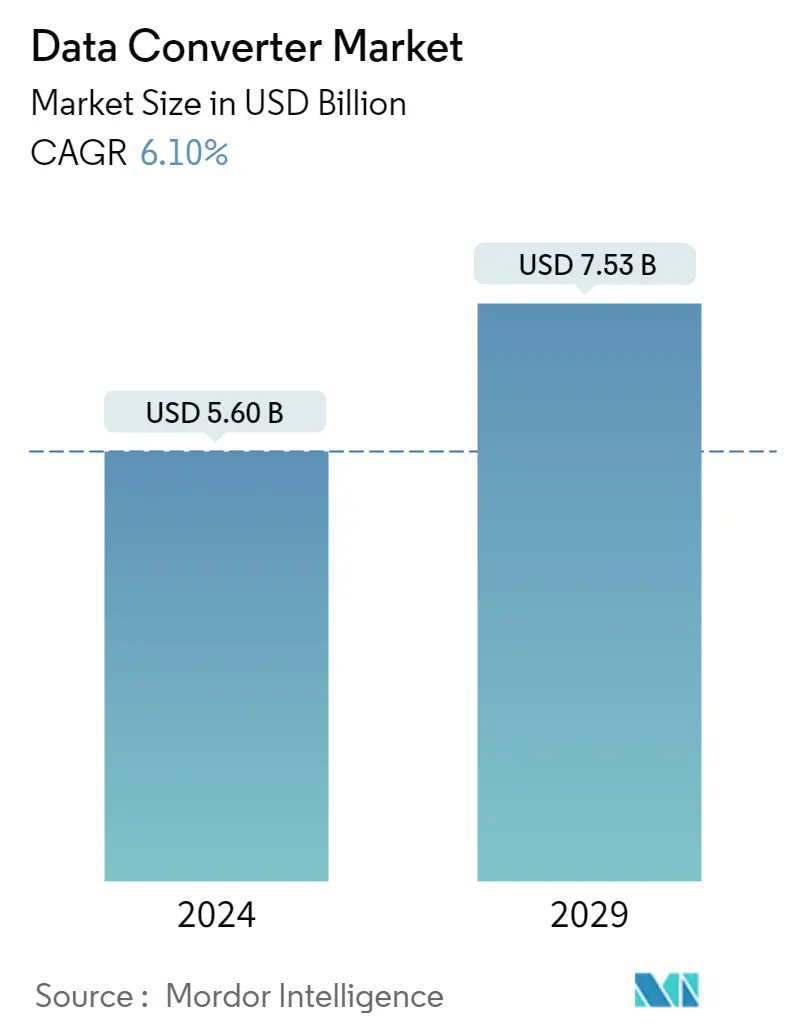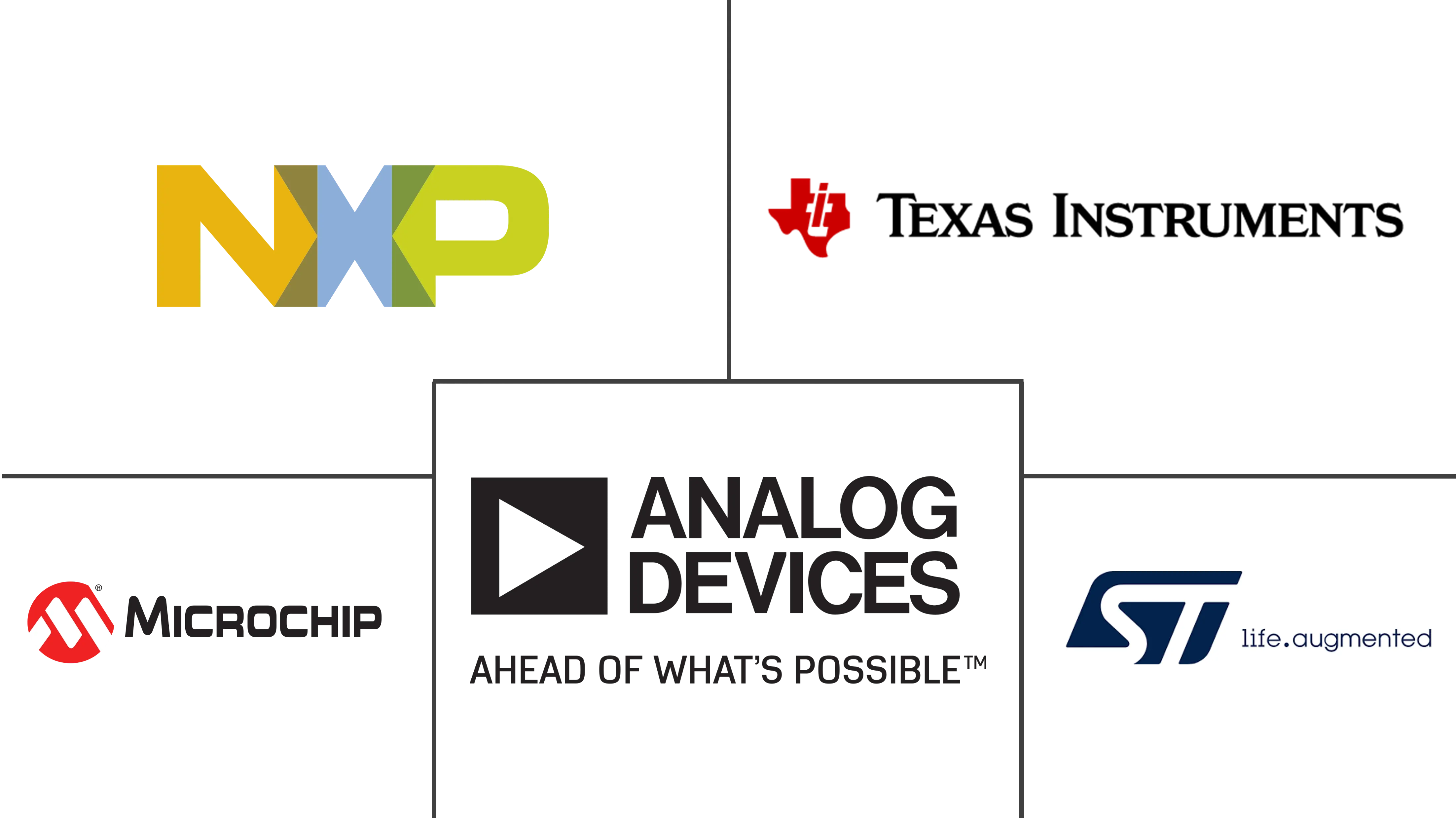Market Size of Data Converter Industry

| Study Period | 2021 - 2029 |
| Market Size (2024) | USD 5.60 Billion |
| Market Size (2029) | USD 7.53 Billion |
| CAGR (2024 - 2029) | 6.10 % |
| Fastest Growing Market | Asia Pacific |
| Largest Market | North America |
Major Players
*Disclaimer: Major Players sorted in no particular order |
Need a report that reflects how COVID-19 has impacted this market and its growth?
Data Converter Market Analysis
The Data Converter Market size is estimated at USD 5.60 billion in 2024, and is expected to reach USD 7.53 billion by 2029, growing at a CAGR of 6.10% during the forecast period (2024-2029).
High-performance electronic systems use more and more high-performance data converters to improve and shape the architecture and open new application perspectives. The emerging circuits and systems techniques at the forefront of state-of-the-art modulators are pushing their performance forward and giving rise to new generations of data converters. Further, the current and future trend depends on old and new factors, including the global economy, technological evolution, and marketing.
- Increasing adoption of technologically advanced data acquisition systems drives the market. The high rates of encoded information in multiple signals forced data acquisition (DAQ) systems to evolve from research work to modern engineering processes. The industry is evolving toward a trend of having a combination of modular hardware and flexible software, where these newer modular systems have appropriate signal conditioning and analog-to-digital conversion (ADC), with various interfacing sensors that support multiple data acquisition requirements.
- The traditional approach for performing specific DAQ tasks is not feasible, considering today's requirements. Thus, a market tends toward a more software-defined approach to DAQ and the emergence of high-speed USB-enabled DAQs.
- Furthermore, the growing demand for high-resolution images in scientific and medical applications is driving the market studied. Data converters constitute the most demanding challenge medical imaging imposes on the electronics design in terms of required dynamic range, resolution, accuracy, linearity, and noise. The ADC (analog to digital) must have a high resolution of at least 24 bits to achieve better and sharper images and a fast sampling rate to digitize detector readings that can be as short as 100 µs in a CT (computed tomography) solution. The ADC sampling rate must also enable multiplexing, which would allow the use of fewer converters as well as the reduction of the size and power of the entire system.
- A company such as Analog Devices addresses these requirements and offer highly integrated solutions for the key signal chain functional blocks to enable best-in-class clinical imaging equipment. Its products, such as ADAS1256 (X-ray applications), ADAS1135, ADAS1134 (CT applications), and many more, drive the market in medical applications.
- Further, the development of low-power consumption data converters challenges the market's growth. Power consumption is one of the leading design constraints in today's integrated circuits. Conversion of the low-frequency bioelectric signals does not require high speed but requires an ultra-low-power operation. This, combined with the required conversion accuracy, makes designing such ADCs a major challenge.
- Further, due to the impact of the COVID-19 pandemic, there is a high effect internationally on supply-demand in the semiconductor industry. For the development of data converters, there is a need for ICs, resistors, capacitors, etc. The breakage in the distribution channel holds slow growth for the data converter market. However, many central and local governments have recognized the strategic importance of the semiconductor industry and prioritized uninterrupted operations for their domestic companies and suppliers in the midst of mandated business closures.
Data Converter Industry Segmentation
A data converter is an electronic circuit that converts analog signals to digital and vice-versa. It is majorly used for end-user applications, such as automotive and telecommunication, which drives the market.
The data converter market is segmented by type (analog to digital converter and digital to analog converter), end user (automotive, telecommunication, consumer electronics, industrial, medical, and other end users), and geography (North America (United States, Canada), Europe (Germany, United Kingdom, France, Italy, and Rest of Europe), Asia Pacific (India, China, Japan, and Rest of Asia-Pacific), and Rest of the World).
The market sizes and forecasts are provided in terms of value in USD million for all the above segments.
| By Type | |
| Analog to Digital Converter | |
| Digital to Analog Converter |
| By End User | |
| Automotive | |
| Telecommunication | |
| Consumer Electronics | |
| Industrial | |
| Medical | |
| Other End Users |
| Geography | |||||||
| |||||||
| |||||||
| |||||||
| Rest of the World |
Data Converter Market Size Summary
The data converter market is poised for significant growth, driven by the increasing demand for high-performance electronic systems and advanced data acquisition technologies. As industries evolve, there is a notable shift towards modular hardware and flexible software solutions, enhancing signal conditioning and analog-to-digital conversion capabilities. This transition is fueled by the need for high-resolution imaging in scientific and medical applications, where data converters play a crucial role in achieving superior dynamic range, resolution, and accuracy. The telecommunications sector, particularly with the advent of 4G and 5G technologies, is also a major contributor to market expansion, as the demand for efficient wireless infrastructure and high-speed data processing continues to rise. Companies like Analog Devices are at the forefront, offering integrated solutions that meet the stringent requirements of modern imaging and communication systems.
North America leads the market, supported by advancements in telecom sectors and the growing use of field-programmable gate arrays (FPGAs) in consumer electronics and automotive applications. The region's automotive segment is experiencing growth due to increased investments in manufacturing facilities and the rising adoption of electric vehicles, which necessitate advanced data converters for various sensor applications. Additionally, the IT and telecommunications sectors in the United States are witnessing substantial growth, driven by the development of 4G networks and the anticipated rise in 5G adoption. The market remains fragmented, with intense competition among key players like Analog Devices, Microchip Technology, and others, who continue to innovate and expand their product offerings to cater to diverse industry needs.
Data Converter Market Size - Table of Contents
-
1. MARKET INSIGHTS
-
1.1 Market Overview
-
1.2 Industry Stakeholder Analysis
-
1.3 Industry Attractiveness - Porter's Five Forces Analysis
-
1.3.1 Bargaining Power of Suppliers
-
1.3.2 Bargaining Power of Consumers
-
1.3.3 Threat of New Entrants
-
1.3.4 Threat of Substitute Products
-
1.3.5 Intensity of Competitive Rivalry
-
-
-
2. MARKET SEGMENTATION
-
2.1 By Type
-
2.1.1 Analog to Digital Converter
-
2.1.2 Digital to Analog Converter
-
-
2.2 By End User
-
2.2.1 Automotive
-
2.2.2 Telecommunication
-
2.2.3 Consumer Electronics
-
2.2.4 Industrial
-
2.2.5 Medical
-
2.2.6 Other End Users
-
-
2.3 Geography
-
2.3.1 North America
-
2.3.1.1 United States
-
2.3.1.2 Canada
-
-
2.3.2 Europe
-
2.3.2.1 Germany
-
2.3.2.2 United Kingdom
-
2.3.2.3 France
-
2.3.2.4 Italy
-
2.3.2.5 Rest of Europe
-
-
2.3.3 Asia-Pacific
-
2.3.3.1 India
-
2.3.3.2 China
-
2.3.3.3 Japan
-
2.3.3.4 Rest of Asia-Pacific
-
-
2.3.4 Rest of the World
-
-
Data Converter Market Size FAQs
How big is the Data Converter Market?
The Data Converter Market size is expected to reach USD 5.60 billion in 2024 and grow at a CAGR of 6.10% to reach USD 7.53 billion by 2029.
What is the current Data Converter Market size?
In 2024, the Data Converter Market size is expected to reach USD 5.60 billion.

